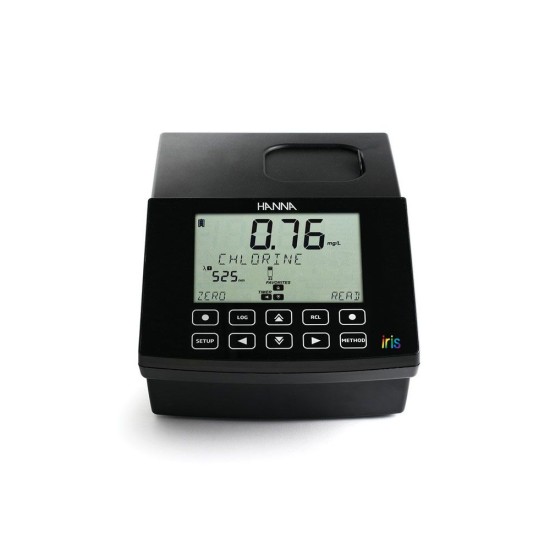
Hanna HI-801 iris Visible Spectrophotometer
Rs. 760,000/-
OVERVIEW:
IRIS portable spectrophotometer is unlike any of the products we have created in the past. It is different from our photometers as it allows for measurement in the spectrum of all wavelengths of visible light and not just pre–specified wavelengths. Spectrophotometers work by isolating light at specific wavelengths from white light. This compact meter incorporates a number of features that facilitate both fantastic
performance and exceptional usability.
- Rechargeable li-ion battery
- User customizable methods
Advanced Split–beam Optical System:
In a spectrophotometer the optical system is the heart of the instrument. Ensuring that the optical system is built with the best design and highest quality materials will guarantee accurate readings and a long life for the meter. When developing this meter our research and development team payed special attention to details and combined many small improvements to a typical spectrophotometer design to create a portable meter with unprecedented performance.
Replaceable Tungsten–Halogen Lamp:
To be able to measure in a wide variety of wavelengths a broadband light source is necessary. In the iris spectrophotometer this is accomplished by a tungsten–halogen lamp. As these lamps do not last indefinitely, it is necessary to change them throughout the life of the meter. The pre–alignment of the lighting fixture guarantees that the bulb is in the same position every time it is changed. This generates peace of mind as there is no need to worry about realigning the light source.
Beam Splitter:
The beam splitter is added to the optical system for use with a reference detector to ensure that the measurement compensates for any drift in the light source. It works by splitting the light emitted by the tungsten lamp into two beams and sending one beam of light to the reference detector that measures intensity. If there are any fluctuations in the light source the meter detects this and compensates through a mathematical calculation. The reference detector also saves battery life and leads to improved speed of the meter as the lamp doesn’t haveto warm-up prior to use.
System Check:
Upon turning on the meter a performance check occurs to confirm that the light source is working properly and to calibrate the position of the grating. The grating calibration works by scanning for the “zero order” light reflecting off the grating. If any mechanical problems are present, the meter will display an alert. This feature establishes confidence in measurements knowing that the meter is always working properly without needing to run any additional tests.
Concave Grating:
This element of the optical system is what generates the spectrum of light. When the light from the tungsten lamp hits the grating it is met with interference coatings that turn the polychromatic white light into a rainbow. This rainbow contains dispersed light at all wavelengths in the visible spectrum. The rotation of this grating is what allows for a specific wavelength to be selected. This ability is one of the biggest differences between a spectrophotometer and a photometer. The concave grating which accomplishes this is superior to other types of diffraction, such as prisms, as it minimizes stray light generated and has constant bandwidth. It also combines elements of the optical system that would typically be separate, for example if a flat grating was used a concave mirror would need to be added in order to refocus the light. The combination of these two pieces creates greater efficiency and a smaller optical system to yield a more compact portable meter.
Narrow Bandwidth and High Resolution:
Having a small bandwidth is necessary to accurately measure narrow peaks. The iris spectrophotometer maintains a narrow bandwidth of 5nm resulting in good spectral resolution. This leads to accurate measurement of sharp, narrow absorbance peaks. Additionally, the high resolution of 1nm generates greater sensitivity as the wavelength is closer to where the sample absorbs the most light.
Low Stray Light:
A common problem in spectrophotometers is stray light. Stray light can be light which is outside the wavelength the meter is measuring or also light at the proper wavelength but from outside the meter. This leads to inaccurate readings as this light would not be absorbed by the sample but would still be detected by the meter. This is a problem that is typically hard to control. Due to the design of the optical system we are able to keep this potential issue to a minimum to improve the linearity and accuracy of readings.
Universal Cuvette Holder and Auto–Recognition:
The cuvette holder built into the meter holds both 22 mm round cuvettes and rectangular cuvettes with a 5cm path length. Adapters for the cuvette holder are available to hold other 13 and 16mm round cuvettes, and 10mm square cuvettes. Rectangular cuvettes have longer path lengths which result in higher sensitivity in readings of low absorbance samples. Additionally, the meter permits the selection of the size of the cuvette used in custom user methods from the available sizes. For all methods, the programmed cuvette size is displayed on the screen to ensure the correct cuvette size is used, ensuring that the proper path length is being used by the meter when calculating measurements.
- Customized Methods:
- Step–By–Step Method Creation
- Up to 10 calibration points
- Flexible calculations for multi wavelength methods
Creating a customized method is easy and intuitive. The HI801 guides you step–by–step through the process of creating your own custom method. The intuitive user interface will guide you through naming your method, setting the measurement wavelengths, creating reaction timers, and calibrating the method. Up to 10 points can be used to calibrate methods.
User Interface:
No one likes to work with difficult equipment, which is why we have worked hard to create an interface that makes the meter’s operation seamless. The intuitive menu design and large LCD screen all make working with the meter a breeze. Get ready for your new favorite piece of lab equipment.
Favorite Methods:
Always have your most frequently used methods readily available with the favorite methods feature. Directly from the home screen is access to user–programmed favorite methods, saving time.
Large High Contrast Custom LCD Display:
With a 6” display, the screen is large and easy to read. The high contrast makes every character on the display stand out even during outdoor use. The wide viewing angle allows for measurements to be seen from far away, so while working around the lab it is not necessary to hover over the meter to see the
measurements.
Capacitive Touchpad:
Maneuvering the menus and using the meter is effortless with the capacitive touchpad. Featuring dedicated buttons specifically for setup, logging data, recalling data, and methods allows for quick and easy access to these functions. There is a key beep feature that can be enabled or disabled, for audible feedback that the key was pressed. Additionally, the meter also still recognizes key touches even through gloves.
General Features:
When choosing a piece of equipment making sure the product has all required features for the intended purposes is critical. When building the iris we included as many features as we could to aid in making this meter exceedingly versatile and convenient. From bare necessities such as long battery life and easy data logging and transfer, we have pushed the limits on seemingly basic features to make your life as easy as possible.
User Methods:
The ability to program up to 100 personal methods into the meter creates both versatility and customization. Methods can include up to 10 calibration points, 5 different wavelengths (which can be used simultaneously), and permits the use of 5 reaction timers. These features allow for many variations to be implemented into methods. Compared to a photometer there is no longer a limitation by factory methods. If a certain parameter is not offered or a modification to a pre–programmed method is required, the meter can be customized to suit your needs.
Pre–programmed Methods:
Programmed in the meter are more than 80 commonly used methods for chemical analysis. Methods can easily be updated by transferring the file from a computer to the meter or by a flash drive. Up to 150 factory methods can be saved in the meter and some chemical parameters have the option to switch between different chemical forms. Finding the product codes to order additional reagents is easy as the meter provides the appropriate reagent codes for each programmed method.
Spectral Range:
The meter features a spectral range of 340nm to 900nm allowing for a wide selection of analytical methods. The flexibility of this range permits compliance with many methods from regulatory organizations and associations for a variety of applications.
Battery Operated:
The meter features a rechargeable lithium ion battery that lasts for approximately 3,000 measurements. Lasting well over a day of use in the field there is no need to worry about the battery life while out working without a power supply. The meter can be quickly recharged with a dedicated fast charging adapter.
Data Logging and Transfer:
Transferring data from a meter should always be simple and straightforward. Impressively the meter can store up to 14,000 measurements in the memory. At any time data can be transferred to a PC or Mac as either a CSV or PDF file. No software is required, simply plug in a flash drive or plug it into a computer and export the data. The ability to save data as a PDF ensures higher integrity of the data as it cannot be easily changed. Additionally, a meter ID and a sample ID can be programmed to be saved along with logged measurements. With technical equipment wide–spread connection compatibility can often be an issue, which is why the iris features USB ports for both flash drive and a direct computer connection. Connectivity with a USB–A port to a flash drive can be used to transfer logged measurements from the meter and also to transfer method updates onto the meter. The USB–B port is used for a direct connection to a computer specifically for transferring logged data.
Document:
| Product Details | |
| Product Name | Hanna HI-801 iris Visible Spectrophotometer |
| Price | Rs. 760,000/- |
| Summary | |
| Battery Life | 3000 measurements or 8 hours |
| TECHNICAL SPECIFICATION | |
| Photometric Accuracy | 5 mAbs at 0.000-0.500 Abs; 1% at 0.500-3.000 Abs |
| Photometric Range | 0.000-3.000 Abs |
| Wave Length Calibration | internal, automatic at power-on with visual feedback |
| Wavelength Selection | 10 mm square, 50 mm rectangular, 16 mm round, 22 mm round, 13 mm round (vial) |
| General Specification | |
| Data Points Stored | 9999 measured values |
| Dimensions | 155 x 205 x 322 mm (6.1 x 8.0 x 12.6″) |
| Environment | 0 to 50 °C (32 to 122 °F); 0 to 95% RH |
| Number of Methods | 150 Factory / 100 User |
| Optical System | split beam |
| Sample Cell | transmittance (%), absorbance and concentration |
| Spectral Bandwidth | 5 nm |
| Stray Lights | <0.1 % T at 340 nm with NaNO₂ |
| Wave Length | Range: 340-900 nm |
| Wave Length Accuracy | ±1.5 nm |
| Wave Length Resolution | 1 nm |
| Weight | 3 kg (6.6 Ibs.) |
| Connectivity | 1x USB A (mass storage host); 1x USB B (mass storage device) |
| Power Supply | 15 VDC power adapter; 10.8 VDC Li-Ion rechargeable battery |
Tags:
hanna
, hi
, 801
, iris
, spectrophotometer
, Hanna HI-801 iris Spectrophotometer | w11stop.com



















